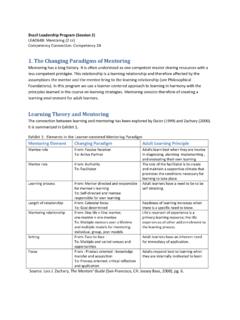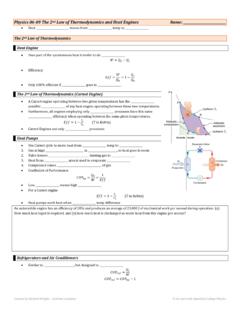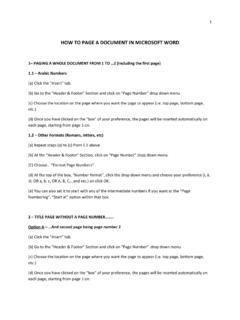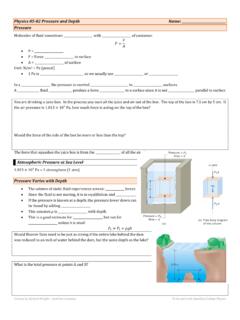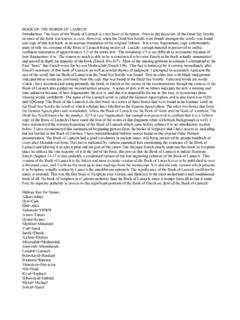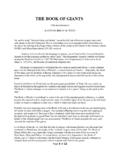Transcription of THE THEME OF APOCALYPTIC WAR IN THE DEAD …
1 Andnws Uniucrsi~ Seminary Strides, Vol. 43, No. 2,261-266. Copyright O 2005 Andrews University Press. THE THEME OF APOCALYPTIC WAR IN THE DEAD SEA SCROLLS ALEXANDER BOLOTNIKOV Hebrew Union College-Jewish Institute of Relqqon Cincinnati, Ohio The THEME of APOCALYPTIC war was widely developed in Qumran literature. The main source of information about the APOCALYPTIC war can be found in lQM, whch Sukenrk named "The War of the Sons of Light against the Sons of Darkness."' According to Paolo Sacchi, "The word ' APOCALYPTIC ' is a modern invention, deriving from the wish to conceptualize the field of research on the affinities between the Apocalypse of John and other works of its time."2 In other words, APOCALYPTIC literature has to have two characteristics: a two- dimensional picture of the world, with heavenly and earthly dimensions both present, and symbolic representation of the main personages. The 'War scroll " seems to comply with these characteristics.
2 The entire content of the scroll is dedicated to the planning of the war between the "faithful" Sons of Light and their enemies. The heavenly realm is constantly projected upon the earthly dimension. Some elements of APOCALYPTIC war are also present in the Pesharim, commentaries found at Qumran that interpret the prophecies about the destiny of the enemies of Israel. The Pesharim can apply these prophecies either to the present reality or to future events. The goal of the present research is to investigate the ideology of APOCALYPTIC war presented in the DSS. In order to gain a better understanding of the nature of this APOCALYPTIC war, and of the character of the Qumran community as well, the present research dl focus on the question of the identification of the enemy in the APOCALYPTIC war. The answer to this question will help to explain the ideology of the community of Qumran in comparison to other Jewish and early Christian communities of that the.
3 The Enemy ofthe Qumran Community The war described in 1 QM definitely has an offensive character. God orders the Sons of Light to attack his and their enemies. Accordmg to Yigael Yam, the war has three In two of these phases, different groups of foes are to be attacked. The offensive against the first two groups is local, whle 'Yigael Yadin, ed., The Scrollofthe War ofthe Sons ofLtght against the Sons ofDarkness (Oxford: Oxford University Press, 1962), 3. 'Paolo Sacci, Jewish Apoca&tic and Its Histoy, vol. 20, JSPSup (Sheffield: Sheffield Academic Press, 1990), 26. the third stage of the war defulitely becomes universalized. The first column of the scroll provides a list of the "local" enemies of the Sons of Light. The enemy is the army of Belial, sons of darkness, hordes of Moab, Edom, Ammon, the Plulistines, and the I(lttim of Ashur. Davies points out that the terms "sons of darkness" and "army of Belial" "seem to be general in application and to define all following group^.)
4 "^ In other words, Davies takes pvm 2~rni ~'IK ~im3 etc. as in apposition to 5~42 5-32 -pin -12. This interpretation makes Moab, Ammon, and other nations to be the incarnated army of Belial, thus projecting the heavenly figure upon the earthly dimension. Based on the type of weapons and other military terminology used in the scroll , Yadm dates this scroll to the second half of the first century ~ The text dehtely does not refer to past events. It rather presents a manual for the warfare that was to be launched in the near The author of the scroll takes the images straight from the prophetic books. Moab, Amrnon, Edom, and the Philistines were ancient enemies of Israel. Most of the prophetic books pronounce woes on them and announce their destruction by God as retribution for their mistreatment of his people. The geopolitical situation in the fust century is certainly different compared to the time of the Hebrew prophets, whch suggests that the names of the nations may be used symbolically.
5 In order to find support for this idea, it is necessary to trace the occurrences of these names in the DSS corpus. The information about Moab, Amrnon, Edom, and the Philistines is scarce. In fact, Arnmon and Edom7 occur only once in the DSS-in this text. The Philrstines appear once in the War scroll , two times in the Pesharim on Isaiah as a part of the biblical text, and in the fragment of 44462, where the context is not clear. Moab occurs as a part of the biblical text in Pesher Isaiah 44165; in the fragment 44175 as part of the text of Num 24; and twice in the War scroll , in columns 1 and 11. The usage of Moab, Arnrnon, Edom, and the Philistines in the DSS does not provide the answer about the purpose of the rhetoric of the author of the War scroll . However, in the army of Belial these nations seem to be secondary. The main thrust of the war is to be directed against the Kittim. In the Hebrew Bible, the Kittim do not appear together with the neighboring foes of Israel.
6 According to the Tanakh, the Kittim were the sons of Javan (Gen 10:4; 1 Chon 1:7), which 4 Philip R. Davies, IQM, the Wm Scrol'~rom Quman: Its Stmct~/re and , Bibkca et Orienfaka, 32 (Rome: Biblical Institue Press, 1977), 114. 'Edom, together with Moab, occurs also in 44434 (BarkiNapht) in the context of prayerful adoration. APOCALYPTIC WAR IN THE DEAD SEA SCROLLS 263 means that they were descendants of Japheth. In the prophetic oracles, the Kittim appear in connection with Tyre and Sidon (Isa 23; Ezek 27), as dwellers of the coastal land distant from Israel (Dan ll:30; Jer 2:lO). Two questions arise from 1QM col. 1. 1. What is the meaning of TUN v:, and n9isn3 nv:,;r? Yadin notes an obvious contradiction between the fact that Ashur is the descendant of Shem, while the Kittim are the descendants of Japheth.' Why would the Kittim live in Ashur and Egypt if they are the dwellers of the western coast lands? 2. Why are the Kith associated with the neighboring foes of Israel, since they have never been described in the Bible as the enemies of Israel?
7 Regarding the first question, A. Dupont-Sornmer suggests that the Kittim of Ashur may be related to the Seleucids. However, another version of the answer to this question may be derived from Num 24:24, which Yadin considers to be very difficult to ~nderstand:~ 'rak '-I? um-njl mq-uyl ~SVH xy1 nig3 7:n 0-31 It is possible that the author of. the War scroll alludes to this passage, using it in two ways: first, he sees that the land of Ashur was conquered by the Kittim; second, he could apply to the "Sons of Light" the role of the destroyers of the Kittim, those who bring the Kittim "to destruction." Davies has addressed the question concerning the presence of the Kittim in Egypt. He reconstructs the broken text in the followingway: "And after this battle the lung of the north shall come up hence with the Kittirn in Egypt."'O In other words, the two expressions do not mean that there are Kittim from Ashur or Egypt, but they could also mean that the Kith conquered these territories.
8 Thls conclusion is consistent with the picture of the Kith elsewhere in the DSS. The word occurs fifty-seven times in the DSS. The majority of occurrences are in different manuscripts of the War scroll (IQM, 44491, 44492). But the remaining occurrences are dstributed among the Pesharirn on Habakkuk, Nahum, Isaiah, and Psalms. The commentators of the Pesharirn tend to make "Kittim" an allegorical representation of different evil things: , in lQl6 the beast in the reeds is "Kittim."" In the Pesher Habakkuk, the Chaldean conquerors are allegorically attributed to the Ktttim. Pesher Nahum's allegorical approach in the interpretation of the lion in "There is a break in the text between the word and awD, but it is likely to be something such as "hordes of Kith." Martinez sees ;I before oq9m, which, if true, can support the statement. Nah 2: 12 serves as the basis for determining the identity of the This is the clearest indication that Pesher Nahum uses "Kittim" as a code word for the Romans.
9 Dupont-Sornmer gives a detaded discussion about the usage of "Kittim" in Pesher Habakkuk. He concludes that even in spite of some indications that "Kittim" could refer to the Sele~cids,'~ the majority of the arguments favor a reference to the Even if some arguments about the Seleucid identity of the Kittirn in Pesher Habakkuk could be based on the early pre-Roman date of the composition of the these arguments could not be applied to the War scroll , which was written after the Seleucid period. If a Roman identification of "Kittim" is valid for the War scroll , then it clearly indicates that the goal for the first stage of the war of the Sons of Light against the army of Belial is to defeat the Romans. The defeat of the Kittim seems to be the major concern of the author of the War scroll throughout the whole book. Since the scroll was written during the Roman rule, the author wanted to hide hs intentions from Roman censorship and make the content of the scroll understandable only to the group that would be familiar with other Qumran materials.
10 Therefore, he was using the code word. However, the code word would still betray the author's intentions. Therefore, he included other nations, such as Moab, Edom, Arnrnon, and the Philistines, to make his work look more biblical and, thus, more misleading to the readers outside the sect. This is a possible answer to the second question presented above. Global Dimensions oftbe War At the thud stage of the war, the Sons of Light were to fulfill the task of defeating the nations living "outside the territory promised to Abraharn."16 This seems like a plan to conquer the world. In addition to the nations mentioned above, col. 2 also mentions Elam, the sons of Ham, Ishmael, and 13A. Dupont-Sommer, The Jetvish Sect 4 Qumran and the Essences: New Studies in the Dead Sea Scrofh, 2d ed. (London: Valentine, Mitchell, 1953), 26-30. APOCALYPTIC WAR IN THE DEAD SEA SCROLLS 265 Ketura. All these nations occur only once in the DSS. In the Hebrew Bible, they occur together only in the genealogy lists of Gen 10 and 1 Chon 1.

